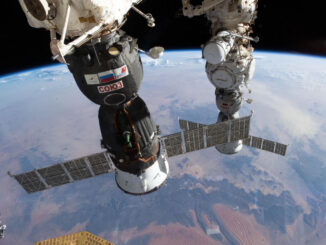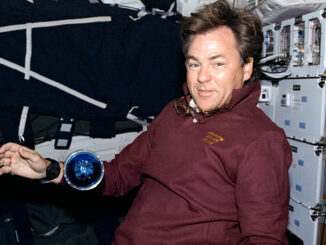
Tensions, which aroused between the United States and the Soviet Union after the Second World War, led to mutual economic and technological rivalry between both superpowers. Part of their competition was to conquer space by achieving consecutive milestones in that field.
The American-Soviet space race gained momentum on 4th October 1957, when the USSR launched Спутник-1 (English: Satellite 1, usually romanised as Sputnik 1), the Earth’s first artificial satellite. The US followed by sending their Explorer 1 spacecraft four months later, on 31st January 1958. Since then, for both countries it was clear that the next step was the first human spaceflight.
For that purpose, yet in 1958, the United States commenced Project Mercury, led by Space Task Group at NASA Langley Research Center in Hampton, Virginia. Goals of the programme were to orbit a crewed spacecraft, then to investigate human’s ability to function in space and, finally, to safely return the spacecraft and its crew member back on Earth.
To create the first US crewed spacecraft, named Mercury, NASA contracted the McDonnel Aircraft Corporation from Saint Louis. Initially, up to seven suborbital test flights of the Mercury, launched with Redstone rockets which were a modified version of short-range ballistic missile SSM-A-14, was planned. Then, orbital flights were to follow with use of more powerful Atlas rockets, once again being a modified version of ballistic weapon, this time intercontinental missile SM-65 Atlas.
On 9th April 1959, when development of the Mercury spacecraft was fully underway, NASA selected the group of candidates for becoming the first man in space. The so-called Mercury Seven included M. Scott Carpenter, L. Gordon Cooper, John H. Glenn, Virgil I. ‘Gus’ Grissom, Walter M. Schirra, Alan B. Shepard and Donald K. ‘Deke’ Slayton. Soon after being selected, all of them began intensive training at Langley Research Center in Hampton, Virginia, as well as Lewis Flight Propulsion Laboratory in Cleveland, Ohio and Naval Air Development Center in Johnsville, Pennsylvania. Additionally, they also participated in U.S. Air Force survival training exercises at Stead Air Force Base in Nevada.

On 19th December 1960, after some initial failures, unmanned Mercury-Redstone 1 mission (MR-1) was eventually launched with success. The test flight proved the capsule and its launcher rocket were capable of reaching the space and to operate there.
Exactly one month later, on 19th January 1961, Alan Shepard was officially chosen for the first suborbital flight, with ‘Gus’ Grissom for the second and John Glenn became the reserve astronaut for the first two. Initially NASA decided not to release the names of the selected future astronauts to the public. Instead, the agency informed that only one of the three men would take part in the first flight and his name would be announced just before launch.
During the second test flight, Mercury-Redstone 2 (MR-2), the spacecraft carried the first US primate. That is because, it was not yet a human, but a chimpanzee named Ham. The MR-2 with the space chimp on board was launched on 31st January 1961 and came back on Earth in less than seventeen minutes later. Nonetheless, it is worth to add that the Soviets already managed to send the first animal into space, female dog named Laika, almost three years earlier. However, she didn’t survive the space flight. Only the next dogs, Belka and Strelka, sent to space by the USSR shortly after, were the first ones to successfully return on Earth. More on the history of the Soviet space dogs can be found in our article issued in April 2023.
Although Ham survived the space flight, returning on Earth safe and sound, an issue with electrical relay in the Redstone rocket was found during the MR-2 mission. That required one more unmanned test flight, designated MR-BD, which took place on 24th March 1961. Only then the Mercury-Redstone launch system was approved to carry the first human into space.
However, the Soviet Union once again proved to be one step ahead of the United States. On 12th April 1961, cosmonaut Yuri Alekseyevich Gagarin (Юрий Алексеевич Гагарин) launched aboard a Vostok spacecraft and officially became the first human in space. Please refer to our article from May 2019 for the complete Gagarin´s story. Despite this fact, NASA continued to prepare its candidates for the first American flight into space. Alan Sheppard, John Glenn and Virgil Grissom went through hundreds of hours of simulations and trainings, including three sessions inside the Mercury capsule.
The launch was scheduled for 2nd May 1961. On that day NASA, following its premise, publicly revealed the name of Alan Shepard to be the first American to fly into space, although the lift-off was scrubbed due to unfavourable weather conditions. Over the next few days, the weather improved, and another launch date was set for 5th May. Despite some technical problems that delayed the start by more than two hours, the second attempt was a success.
On 5th May 1961 at 9:34 a.m. ET (2:34 p.m. UTC), MR-3 mission began. The Redstone rocket carrying the Mercury spacecraft named Freedom 7 with Alan Shepard on board, lifted-off from Launch Complex 5 at the Cape Canaveral Air Force Station in Florida.
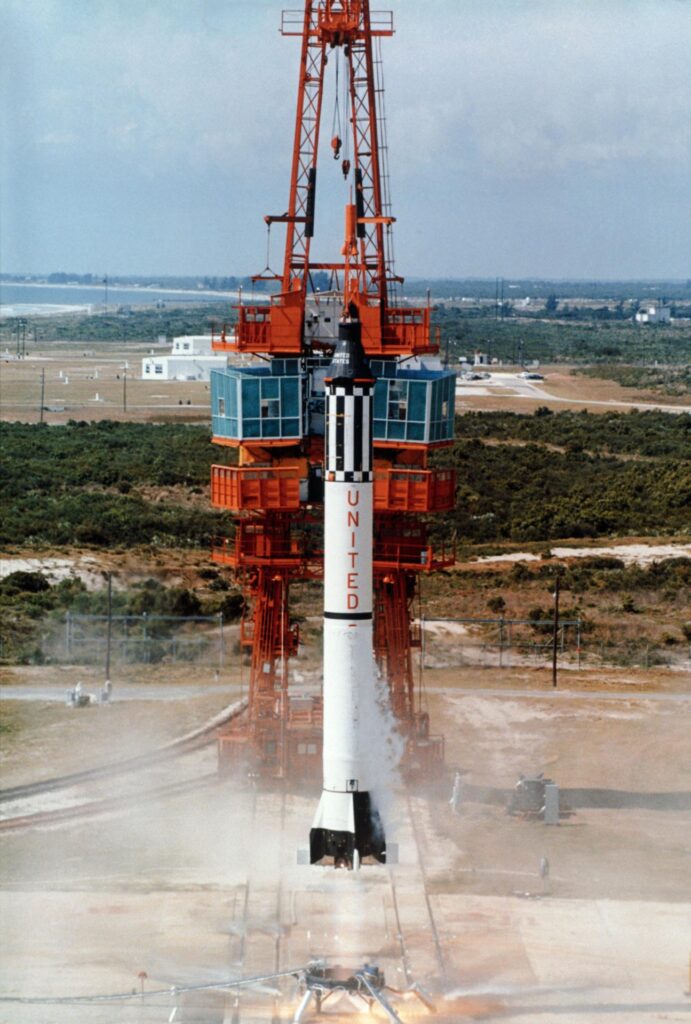
That historical moment of the first American flying into space was directly witnessed, according to estimations, by 500,000 people gathered on the beaches near the spaceport, as well as followed by further forty-five million US citizens, including President John F. Kennedy himself, through live television broadcast.
During the whole flight, the astronaut was in constant radio contact with the Mercury Control Centre at Cape Canaveral. Interestingly, the role of CAPCOM (Capsule Communicator), responsible for direct contact with Shepard, was entrusted to one of the aforementioned seven initially chosen candidates for the flight, ‘Deke’ Slayton.
At T+ 2 minutes and 22 seconds into the flight, engines of the Redstone launch vehicle cut off as planned, followed by jettisoning of the launch escape system tower from top of the capsule. Ten seconds later, the Freedom 7 spacecraft separated from the rocket and Alan Shepard began to feel the weightlessness of microgravity, which he experienced for the following five minutes of the flight.
At T+ 3 minutes and 10 seconds into the flight, Shepard took over manual attitude control of the spacecraft for a while. Controlling its position turned out to be surprisingly easy and precise. Then, the astronaut took a moment to look at the Earth below him through the capsule window and took some pictures of the Atlantic Ocean covered in clouds.
At T+ 5 minutes and 11 seconds, the Freedom 7 reached its suborbital flight apogee of 116 miles (186.86 kilometres) and shortly afterwards began to descend. Soon, the spacecraft automatically began retro-fire manoeuvre.
At an altitude of 230 000 feet (70,104 metres), the spacecraft began to break through the highest parts of the Earth’s atmosphere. The feeling of weightlessness disappeared, and the gravitational force began to act on Shepard’s body. The peak momentary g-force the astronaut faced during the re-entry was as high as 11 G.
When the spacecraft reached altitude of 22,000 feet (6,705.6 metres), its drogue parachute was automatically deployed, stabilizing and slowing the capsule down. At altitude of 10,000 feet (3,048 metres), the main parachute opened, followed by deployment of the landing bag at the bottom of the spacecraft in order to soften the landing.
At T+ 15 minutes and 22 seconds, the Mercury 7 spacecraft splashed down safely into the waters of the Atlantic Ocean, 300 miles (482.8 kilometres) from the Cape Canaveral and north of the Bahamas Islands. It was 9:49 ET (14:49 UTC), when Alan Shepard returned on Earth as the first American and second man in history to fly into space.

Twenty minutes from the splashdown, the first US astronaut was retrieved from the Freedom 7 capsule by a helicopter from the recovery ship – the USS Lake Champlain (CVS-39) aircraft carrier. Already on board the ship, Shepard was subjected to a quick medical examination and received a congratulatory phone call from the President John Kennedy.
Less than two-and-a-half hours after returning on Earth, Shepard boarded an aircraft that took him to Grand Bahamas Island where he underwent a more thorough medical examination. Meanwhile, his spacecraft was retrieved from the ocean waters by a helicopter and transported to the Cape Canaveral Air Force Station.
On 8th May 1961, Alan Shepard with his wife Louise visited Washington D.C. and attended special ceremony held in the Rose Garden of the White House, during which the first American astronaut was honoured by the US President John F. Kennedy with NASA highest award, the Distinguished Service Medal. Then, Shepard and his wife were driven in a limousine of the US Vice President Lyndon B. Johnson to the Capitol to receive a reception with lawmakers.
At press conference held shortly after Shepard’s space flight, President Kennedy announced that he would be seeking funding for a significant expansion of the US space programme. Later, on 25th May 1961, the US President attended a joint session of Congress in the Capitol. During the speech he delivered, he announced the plan to send humans to the Moon and return them safely to Earth, yet before the end of the then decade.
This declaration by the President John F. Kennedy, which soon afterwards resulted in commencement of NASA Apollo programme, culminated with a series of manned landings on the Moon – the first of them took place on 20th July 1969, within the Apollo 11 mission (please follow here to read more about this mission) – was undoubtedly directly influenced by Alan Shepard’s path-breaking suborbital space flight.
It is worth to mention that on the same day that the President of the United States declared the plan to send men to the Moon, the spacecraft of Alan Shepard made its way to France. There, for the next few days, it could be seen on static display during the 24th International Aeronautical Exhibition and the 1st Space Salon (24e Salon International de l’Aéronautique et 1er Salon de l’Espace) in Paris.
For Alan Shepard, the MR-3 mission was just the beginning of his astronaut career. After becoming the first American in space, he was assigned as a pilot on the Mercury-Atlas 10 mission with Virgil Grissom as backup pilot. The MA-3 mission, with the spacecraft named Freedom 7-II in reference to Shepard’s previous capsule, was initially scheduled for October 1963, but was cancelled in June of that year.
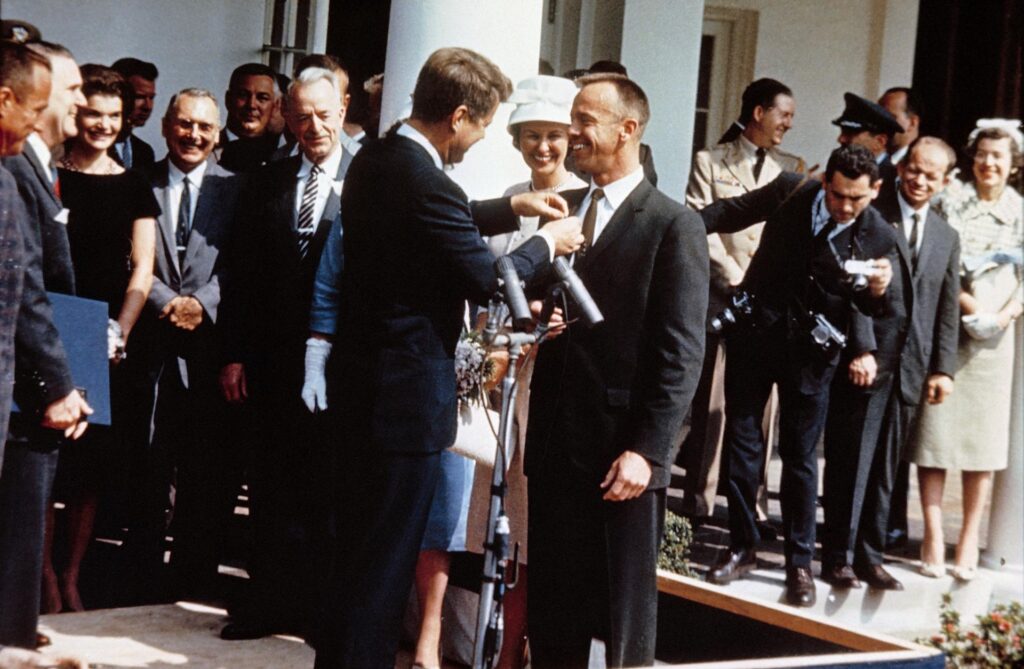
As a result, Shepard was soon assigned the role of commander-pilot in Gemini III scheduled for March 1965. That was the first crewed mission of Project Gemini – the NASA programme that followed the Mercury and was intended to develop advanced spaceflight techniques for the purposes of the Apollo programme.
Unfortunately, at the beginning of 1964, Shepard was diagnosed with Meniere’s disease, associated with build-up of pressure in the inner ear, extreme hyper-sensitivity of the sense of balance and consequent disorientation and nausea. At the time, there was no effective treatment for the disease, and in only twenty per cent of cases the condition would remit by itself. In result, Shepard was excluded from space flights until the late 1960s.
However, his medical condition did not mean the end of his career at NASA. As late as November 1963, Shepard was appointed the Chief of the Astronaut Office and received the title of Chief Astronaut. From now on, his responsibilities included overseeing coordination, planning and control of all NASA astronaut-related activities, including preparation and implementation of training programmes to ensure readiness of ground crew and pilots for manned missions; collecting pilot evaluations of design, construction and performance of spacecraft subsystems and ground equipment; creating qualitative scientific and engineering assessments to support overall mission planning, formulating operational procedures, selecting and conducting individual experiments for each flight.
In 1968, a chance to cure Shepard´s disease emerged. In May of that year, he underwent surgery at St. Vincent’s Hospital in Los Angeles, in accordance with newly developed method of treating Meniere’s disease. The surgery was successful, and, on 7th May 1969, Alan Shepard was reinstated to full flight status.
He was soon assigned as an astronaut within the Apollo programme. First, as commander of the Apollo 13 mission, but he was soon reassigned and designated as commander of the following Apollo 14 – the one with which Alan Shepard flew into space for the second time.
The Apollo 14 mission, with the crew of Spacecraft Commander Alan B. Shepard, Command Module Pilot Stuart A. Roosa and Lunar Module Pilot Edgar D. Mitchell, was flown from 31st January to 9th February 1971. It was the third successful US mission to land humans on the Moon. Alan Shepard became the fifth and, at the age of 47, the oldest man to walk on the surface of the ‘silver globe’ and the only one of the Mercury seven astronauts to do so.
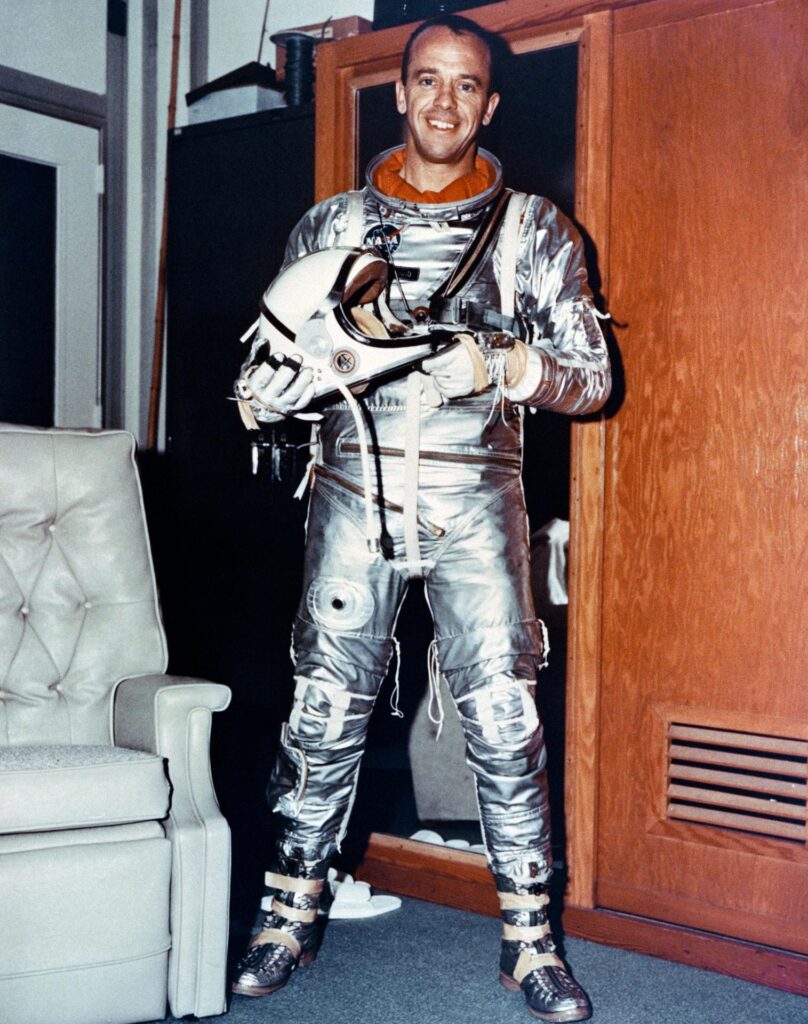
Alan Shepard spent a total of 216 hours and 57 minutes in space, including 9 hours and 17 minutes during EVA (Extravehicular Activities) on the lunar surface.
He returned to his duties as Chief of the Astronaut Office in June 1971 and served in that position until his retirement from NASA and the US Navy on 1st August 1974.
As the retired NASA astronaut and Rear Admiral of the US Navy, Shepard ran a private business in Houston, Texas, and served as president of the Mercury Seven Foundation – a non-profit organisation that provides academic scholarships to deserving students.
In 1996, Alan Shepard was diagnosed with chronic lymphocytic leukaemia. He died on 21st June 1998 at the age of 74. His wife, Louise, died five weeks later of a heart attack.
The name of Alan Shepard is still alive today, also in pop culture. One of the US Navy supply ships carries the name USNS Alan Shepard (T-AKE-3). In commemoration of the first American astronaut, Commander Shepard is the main character of the space science fiction game trilogy ‘Mass Effect’. Blue Origin, the private space company founded by billionaire Jeff Bezos, had named its fully reusable sub-orbital launch vehicle developed for space tourism, New Shepard.
At this point it is worth to mention also that, on 11th December 2021, twenty-three years after Alan Shepard’s passing, his daughter Laura Shepard Churchley flew into space, just aboard the mentioned New Shepard suborbital rocket of the Blue Origin company.
The Freedom 7 (the number signifies all the Mercury astronauts) spacecraft, with which Alan Shepard made history flying into space, can be currently seen on display at the Smithsonian National Air and Space Museum in Washington, D.C. Additionally, a recreated Mercury Control Centre can be visited in the Kurt Debus centre, at NASA Kennedy Space Centre’s Visitor Complex.

Cover photo: The liftoff of the Mercury-Redstone 3 (MR-3) on May 5, 1961, piloted by astronaut Alan B. Shepard, Jr., whose portrait is in inset. (Photo by NASA – S62-01151)
Sources – National Aeronautics and Space Administration (NASA) and Wikipedia

